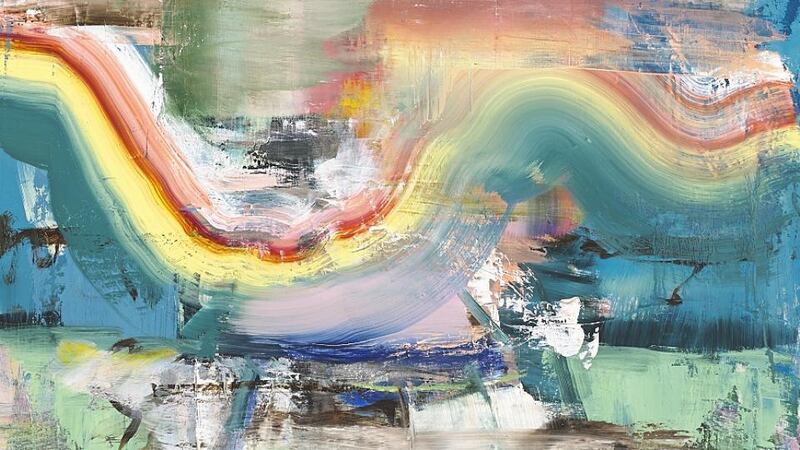The Floating World – Clare Langan
Visual Centre, Carlow
****


If you were asked to sum up Clare Langan's The Floating World in three words, you could try: location, location, location. She is known for her dreamy, ominous film meditations on deserted, post-apocalyptic worlds, and usually finds appropriately disorienting, visually enthralling settings.
For this three-screen installation, she had a trio of them: the stark pinnacles of Skellig Michael, the skyscraper city of Dubai, and abandoned habitations in parts of Montserrat that were overwhelmed by lava and ash following a volcanic eruption in 1995.
Langan’s films are like contemporary variants of landscape painting. There’s movement in them, typically drifts of mist or cloud or bits of ash carried on the air, but it’s often the camera that does the moving, and the core subjects – the landscape and buildings – are static. Rather than linear narrative, she creates pools of time.
The soundtracks are also aural landscapes. For The Floating World, the ambient music by Jóhann Jóhannsson is augmented by sound works, environmental recordings by Jana Winderen.
The cinematography, never less than spectacular, is by Robbie Ryan. If one were to risk applying any kind of narrative logic, the end is at the beginning, on Skellig Michael. Shot in wintry black and white, it appears dusted with snow, whether in actuality or by optical distortion created by the use of infrared film. Either way, it is effectively bleak.We glimpse a distant figure, carefully picking her or his way up the vertiginous steps towards the unlikely looking refuge of the monastic stone buildings.
This figure, we might infer, is a sole survivor of an environmental disaster. Nothing so specific is ever spelt out, but then Skellig Michael was, famously, a rather extreme refuge where elements of Christian civilisation managed to cling on during the dark ages. From antiquity we jump to ultra-modernity. As visualised here, Dubai is a city in the clouds, a panorama of skyscrapers floating above the invisible Earth, like so many Towers of Babel.
What we see of Montserrat is perhaps the world that the protagonist we glimpse has had to abandon: dilapidated buildings swamped by drifts of molten rock and ash. Everything is scorched, disintegrating and fading. Langan is offering us a contemporary take on the sublime. It’s certainly ravishing to look at and terrible in its beauty.
The film is open to several layers of interpretation. Most tempting, perhaps, is to see it as alluding to the threat of environmental disaster, triggered by our own actions. One of its strengths – its refusal to spell out a precise meaning – could also be a weakness. To apparently travel some way in a particular direction in terms of both meaning and position and then opt for pure metaphor seems potentially counter-productive.
On the other hand, maybe the aim is to bring the viewer to a clearer understanding of what is at stake by dealing with it in an abstracted way, surely a valid approach. As an audiovisual spectacle, it's irresistible. Until May 3rd, visualcarlow.ie
A Million and One Things Under the Sun – Diana Copperwhite
Kevin Kavanagh Gallery, Dublin
*****
What’s the difference between painting and juggling? In Diana Copperwhite’s case, probably not much. In her paintings at Kevin Kavanagh she devotes a lot of energy to keeping things up in the air, to not letting a composition settle down into a single image.
You feel she wants to preserve them as bundles of potential, fizzing with energy, as if each is a box containing Schrödinger’s cat – very much enjoying the cream, thank you – until we open the lid and decide whether it’s living or dead. At one extreme, theories of the multiverse predict the exponential multiplication of universes. Copperwhite’s quantum chromodynamics stop short of that, but she does like to keep her – and our – options open.
Intriguingly, she does so within two well-established genres of picture-making: the interior and the portrait. Walk around her exhibition and you’ll get an object lesson in how to stop an interior becoming an interior and a portrait a portrait within the meaning of the act. Instead, we are constantly offered spaces and likenesses ready to accommodate the meanings we read into them.
It's tempting to interpret her work as a response to our contemporary technological environment, but it's more fundamentally a visual response to the reality of how we experience, relate and respond to our world, to others and to time and memory. Until April 25th, kevinkavanagh.ie
Cosmic Dust Curated by Emma-Lucy O’ Brien
Visual Centre, Carlow
***
Cosmic Dust is a very good, thoughtful show but one that is, in context, overly theorised and lacking in visual punch. It aims to look at "ways in which art, science and the spiritual can overlap to offer a deeper understanding of our metaphysical existence".
The main gallery in Carlow's Visual is big. And it does demand a curatorial response other than to pretend that it's not really that big. Unfortunately for an exhibition that encompasses the universe, Cosmic Dust opts for exactly that and fizzles out in its finite but considerable expanse.
It's not saved by Remco de Fouw's otherwise sterling chalk installation, because it is low-rise and on the floor. Rudolf Steiner's blackboard diagrams, rescued from the anthroposophy theorist's lectures by enthusiastic fan Emma Stolle, are dry documents. Anita Groener's painting Frequency introduces a spark of life, but it's not picked up, although Ruth Lyons's vessels carved from rock salt make a brave effort before being overwhelmed by the space.
Martin Healy's intriguing film Aether, about an attempt to make a perpetual motion machine, is secluded in its own theatre. There's nothing bad and much that's good in Cosmic Dust, but in terms of the location and the scale, there is a missing link. Until May 17th, visualcarlow.ie









